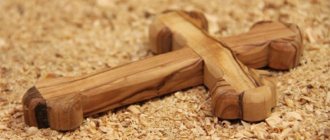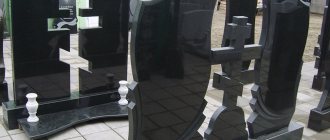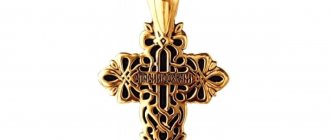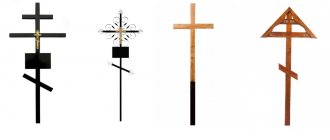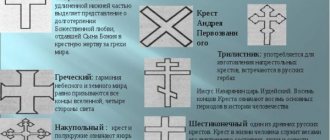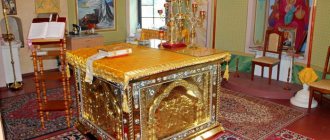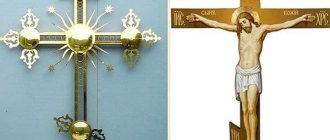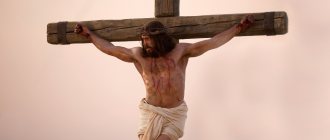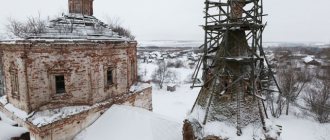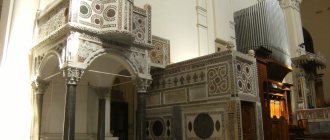"Save me, God!".
Thank you for visiting our website, before you start studying the information, please subscribe to our Orthodox community on Instagram, Lord, Save and Preserve † - https://www.instagram.com/spasi.gospodi/. The community has more than 60,000 subscribers. There are many of us like-minded people and we are growing quickly, we post prayers, sayings of saints, prayer requests, and timely post useful information about holidays and Orthodox events... Subscribe. Guardian Angel to you!
Just as there are a large number of different religions, there are also a variety of symbols of such faith. The most widespread is Christianity. Regardless of whether believers belong to Orthodoxy or Catholicism, representatives of both of these branches honor and wear crosses. There is a certain difference between the Orthodox and Catholic crosses, which you need to know in order not to get into an unpleasant situation.
Cross shape
For Orthodoxy, the shape of the cross is not particularly important; much more attention is paid to what is depicted on it, however, eight-pointed and six-pointed crosses have gained the most popularity.
Since ancient times, the eight-pointed cross has been considered the most powerful protective tool against various kinds of evil spirits, as well as visible and invisible evil. Its eight ends are a reflection of eight periods of human history, the eighth being the Kingdom of Heaven. The upper crossbar of the cross, distinguished by its small size, symbolizes the tablet that was nailed over convicts in ancient times with explanations of their crimes. The oblique crossbar at the bottom of the cross has two meanings. Firstly, this is a footstool, similar to the one that was present at the crucifixion. The second meaning of this crossbar is more symbolic. It means an imbalance in the sinful world, and indicates the path of rebirth and movement towards heavenly light.
The six-pointed cross was widespread among Orthodox believers, especially during the times of Ancient Rus'. It also has an inclined crossbar, but the meaning is somewhat different. The lower end symbolizes unrepentant sin, and the upper end symbolizes liberation through repentance.
The Catholic Church uses only one image of the cross - a simple, quadrangular one with an elongation of the lower part.
However, all its strength does not lie in the shape of the cross or the number of ends. The cross is famous for the power of Christ crucified on it, and this is all its symbolism and miraculousness.
History of the cross
Even before the advent of Christianity, the cross, as a magical sign, was widely used among pagan peoples. In Egypt, the veneration of the cross dates back to the 15th century BC. Interestingly, the Egyptians’ cross was enclosed in a ring and was called the Ankh.
The Egyptians believed that it was a symbol of life and the gods and painted it on mummies. The tradition of venerating a cross of this form spread to the following civilizations - Babylon and its colony Assyria. Later, a similar cross became a symbol of the Freemasons.
See also: Books about Freemasons and the End of the World. Benefit or harm?
Archaeological finds confirm that in pre-Christian times the cross was also used for religious purposes on more distant continents - North and South America, Asia. In India, the cross was depicted on the hands of the god Krishna. In Peru, the cross was believed to drive out evil spirits.
Therefore, the Christian philosophers of the first centuries, Tertullian and Minucius Felix, pointed out in their writings that the cross was known to the pagan peoples and was revered by them.
At the same time, in the Roman Empire the cross was considered an instrument of execution. In the only monotheistic religion at that time - Judaism - the cross was not mentioned at all. Although we see prototypes of the cross in many places in the Old Testament.
According to the Old Testament, Moses sent poisonous snakes against the Israelites because they complained about him. When the Israelites repented and begged for mercy, Moses installed a copper serpent on a T-shaped pole to ward off the real snakes. According to legend, such a copper serpent had healing powers.
However, it was wild for the Jews to accept that the long-awaited Messiah would die on the cross. The Apostle Paul points to this in the words: “We preach Christ crucified, a stumbling block to the Jews, and foolishness to the Greeks” (1 Cor. 1:23).
Worship of the cross among Christians has been known since the end of the 2nd century. From pagan sources we know that Christians were then called crucis religiosi or cross-worshipers. Such an epithet was not rejected by Christian apologists and Church Fathers.
In the first centuries of Christianity, the Church did not establish any mandatory form of depiction of the cross. It was drawn in free form, which is confirmed by modern archaeological research. The main thing is that the image at least vaguely resembles a cross.
The period before the Ecumenical Councils is characterized by the monogram of the cross as the name of Christ. Currently, decorations in the form of the name of Christ can often be found in Orthodox stores and candle shops.
The main elements of such a monogram are the letters “X” and “P”. The letter "X" stands for the name Christ. In it, Christians of the first centuries expressed their faith and the whole essence of Christianity. The monogram of the name of Christ with the letter “X” was so popular that the Roman emperors - persecutors of Christians - designated the fight against Christianity as the fight against X.
In 355, the symbol “P” appears in the monogram of the name of Christ, which denotes the second letter in the name of Christ. From the second half of the 4th century, this symbol became the main one in Christianity. In the first centuries in Christianity, the image of the cross as such had not yet been established. This is due to numerous persecutions of the Church.
There is a known image of a cross, which is inscribed on the labarum of Constantine the Great. It was under this sign that Constantine’s troops won victory after the appearance of the cross in heaven.
It is clear that what gave this banner its Christian character was not the cross itself, but the monogram of the name of Christ. Subsequently, the emperor continued to use this image as his flag.
Only from the second half of the 4th century did the symbolic forms of the cross in the form of a monogram of the name of the Son of God begin to give way to their own image of the cross. During the reign of Emperor Theodosius, Christianity finally triumphed over paganism. Images of the cross begin to openly appear in all spheres of Roman life - in the Church, in state paraphernalia, in everyday life. As St. John Chrysostom noted: “The cross is everywhere.”
The position of Jesus' body on the cross
If the shape of the cross most often does not matter for believers and servants of the Lord, then the position of the body of Jesus is a fundamental disagreement between these two religions.
In the Catholic Crucifixion, the image of Christ has naturalistic features. It reveals all human suffering, the torment that Jesus had to experience. His arms sag under the weight of his body, blood streams down his face and from wounds on his arms and legs. The image of Christ on the Catholic cross is plausible, but it is an image of a dead man, while there is no hint of the triumph of victory over death.
The crucifixion in Orthodoxy symbolizes this triumph. It contains humility and joy of resurrection. Jesus' palms are open, as if he wants to embrace all humanity, giving them his love and opening the way to eternal life. He is God, and his whole image speaks of this.
The meaning of the cross in Christianity
This symbol has long been revered by Orthodox and Catholics as a symbol of Christ's victory of good over evil, as well as a symbol of hope for eternal life. A person receives a cross as a sign of his membership in the Church. At baptism, a person renounces Satan and recognizes the full power of the Lord over himself. This item also symbolizes strong protection and protection from dark forces.
Knowledge of such subtleties will help you accurately identify the Orthodox or Catholic cross in front of you. But if a mistake did occur or you deliberately bought a cross you liked, then do not rush to hide it or get rid of it. Approach the priest and ask him to bless you. Perhaps they will meet you and he will accompany you for a long time.
The best article for you, go to: Maslenitsa is a holiday of the Russian people
The Lord is always with you!
Inscriptions on the cross
The inscription on the tablet attached above the head of Jesus, where there should have been a description of his offense, is also different. But since Pontius Pilate did not find how to describe the guilt of Christ, the words “Jesus of Nazareth, King of the Jews” appeared on the tablet in three languages: Greek, Latin and Aramaic.
And the only difference in the image of this inscription on the cross is that this inscription (one and the same) is written in Latin in Catholicism and has the form INRI, and in Orthodoxy - IHHI.
| Catholic cross |
|
Difference between Catholic and Orthodox cross symbol
Their main difference lies in the image and inscriptions. Having carefully studied them, one can say with almost complete certainty which movement of Christianity this subject belongs to.
Inscriptions
You can determine the ownership of an item by the inscription at its top. In the Latin version, the abbreviation for the words “Jesus of Nazareth, King of the Jews” is “INRI”. There can be two types of inscriptions on an Eastern Christian cross: IHHI or IHCI. In addition to this abbreviated inscription, it contains the following letters:
- IC XC - Jesus Christ;
- TS - King of Glory;
- NK - NIKA, which means winner.
Only the Orthodox Christian symbol has the inscription “Save and Preserve” on the reverse side.
Image
The greatest differences are observed in the depiction of the figure of the Savior. The Orthodox image depicts the Son of God conquering death. His arms are calmly spread to the sides with open palms. It seems that Jesus embraces all people. The head is surrounded by a halo and the eyes are open. The legs stand on the crossbar, or nail one at a time to the vertical part.
Read about Christ:
- Suffering on the Cross of Jesus Christ
- Death of Jesus Christ
- Resurrection of Jesus Christ
Most often, Catholics depict the cross as four-pointed.
The Catholic depiction of Christ is more realistic. The figure literally hangs on a cross-shaped structure, nailed to it with three nails. A crown of thorns is put on his head, from under which blood flows onto his face. Wounds are also visible on other parts of the body. The eyes on his drooping head are always closed.
You should know that the crucifix of Eastern Christians is flat, while for Catholics it protrudes above the surface.
Conclusions TheDifference.ru
- The Orthodox cross most often has an eight-pointed or six-pointed shape. The Catholic cross is four-pointed.
- The words on the sign on the crosses are the same, only written in different languages: Latin (in the case of a Catholic cross) and Slavic-Russian (on an Orthodox cross).
- The feet of Jesus Christ are placed together on a Catholic Crucifix, and each is nailed separately on an Orthodox cross.
- The Orthodox cross depicts God, who opened the path to eternal life, while the Catholic cross depicts a man experiencing torment.
What does the Orthodox cross mean?
There are many secrets hidden in the crucifixion. For the Orthodox, this is a kind of strongest amulet against the evil spirit, the evil eye, and unpleasant accidents. They are worn without taking them off. Once upon a time, when a child left home or left his father's house, a cross was tied around his neck. It was called wearable.
The mind must honor the words of prayer, the laws of God. The heart must be in repentance and tears for sinful actions.
During baptism, a cross is also worn. It is believed that by removing it, you open the way for dark forces to reach the baby. Therefore, the rope or chain is made so long that it is comfortable for the child and cannot be removed.
When you enter church, you mark yourself with a cross, this is a righteous sign and faith in its power.
Eight-pointed Orthodox cross
Christ was executed on such a crucifixion.
And only when they drove the nail into the feet, a foot appeared at the crucifixion. After this, they attached the top bar at the headboard with the inscription. This is how the eight-pointed crucifix appeared, now known throughout the world.
It can also be considered as eight periods of human life. The eighth is another world, a future life. One end looks towards the Kingdom of God. The crossbar for the legs speaks about sin on earth, that Jesus broke stereotypes, showed people that there is God, explained to them what sin is.
Schema cross, or “Golgotha”
The inscriptions and cryptograms on Russian crosses have always been much more diverse than on Greek ones. Since the 11th century, under the lower oblique crossbar of the eight-pointed cross, a symbolic image of the head of Adam appears, and the bones of the hands lying in front of the head are depicted: right on left, as during burial or Communion. According to legend, Adam was buried on Golgotha (in Hebrew, “place of the skull”), where Christ was crucified. These words of his clarify the tradition that had developed in Rus' by the 16th century of making the following designations near the image of “Golgotha”:
- "M.L.R.B." - the place of execution was quickly crucified
- "G.G." - Mount Golgotha
- "G.A." - head of Adamov
- The letters "K" and "T" stand for the warrior's copy and the cane with a sponge, depicted along the cross.
The following inscriptions are placed above the middle crossbar:
- “IC” “XC” is the name of Jesus Christ;
- and under it: “NIKA” - Winner;
- on the title or near it there is an inscription: “SN” “BZHIY” - Son of God,
- but more often “I.N.C.I” - Jesus of Nazareth, King of the Jews;
- the inscription above the title: “TSR” “SLVI” means King of Glory.
Such crosses are supposed to be embroidered on the vestments of monks who have accepted the schema - a vow to observe particularly strict ascetic rules of behavior. The Calvary cross is also depicted on the funeral shroud, which marks the preservation of the vows given at Baptism, like the white shroud of the newly baptized, signifying cleansing from sin. When consecrating churches and houses, the image of the Cross “Golgotha” is also used on the walls of the building in the four cardinal directions.
What does the crescent on the cross of an Orthodox church mean?
It was used in ancient times to decorate church objects. It is also visible under the dome of the Hagia Sophia, on the door drawings of the Nizhny Novgorod Cathedral. Quite common. Has a crescent, which is located at the base of the cross. They are installed on the domes of temples and churches. It signifies the birth of Jesus. They can also interpret it as the Mother of God.
There is an opinion that such a designation gives the Orthodox faith an advantage over the Muslim faith. But Muslims had such an image of the cross much earlier than it appeared in Orthodoxy.
In reality, it is a cross anchor. In the old days, the church was a lifeboat; it guided the laity to the true path, showed them the way to the Kingdom of God.
Encolpion - reliquary cross
Reliquaries, or encolpions (Greek), came to Rus' from Byzantium and were intended to store particles of relics and other shrines. Sometimes the encolpion was used to preserve the Holy Gifts, which the first Christians during the era of persecution received for Communion in their homes and had with them. The most common were relics made in the shape of a cross and decorated with icons, as they combined the power of several sacred objects that a person could wear on his chest.
The reliquary cross consists of two halves with indentations on the inside, which form a cavity where the shrines are placed. As a rule, such crosses contain a piece of fabric, wax, incense, or just a tuft of hair. When filled, such crosses acquire great protective and healing power.
The meaning of the Orthodox cross
The cross is an integral part of Orthodoxy. Denotes the crucified Jesus and the life he gave for us sinners. Atheists think that Orthodoxy worships the instrument that killed Christ. But this is far from true. Believers worship the symbol of eternal life. The Church says “the life-giving cross,” which means that Jesus, in terrible agony, begged the Almighty for the forgiveness of sins and eternal life for the laity.
By putting a cross on themselves, Orthodox Christians honor the Almighty, His laws, and fulfill the Word of God. They accept humility and receive blessings. That is why the cross is the redemptive power of faith for the life Jesus gave.
Types of Orthodox crosses
Patriarchal cross
Used in the middle of the last century. Such a large cross is located in the Museum of Russian Art.
Four-pointed cross
“All-honorable cross, four-pointed power, blessing to the Apostles.”
Six-pointed cross “Russian Orthodox”
This crucifix has its purpose. The lower bar serves as a kind of scale of good and bad deeds. This is how Jesus defined the two criminals who were crucified on either side of him. One of them repented and departed into another world with a pure soul, and the second blasphemed Christ and ended up in hell.
Eight-pointed cross
Christ was executed on a four-pointed crucifix. And only when they drove the nail into the feet, the lower bar, the foot, appeared at the crucifix. After this, they attached the top bar at the headboard with the inscription.
This is how the eight-pointed cross, now known throughout the world, appeared.
Seven-pointed cross
Such crosses were depicted in 1500 in northern Russia. They are also installed on the domes of Russian churches.
Cross “crown of thorns”
“The whole earth is cursed because of you. Only thorns will grow,” these were God’s words to Adam. Jesus, without coercion, took upon himself all the sins of mankind, and the crown of thorns is like the thorny road he passed while carrying the cress for crucifixion. Completely atoned for Adam's sin.
Cross “gallows”
Such crucifixes can be seen in almost all churches. All church objects are crowned with them.
Cross “grapevine”
I am the true vine, and My Father is the vinedresser” (John 15:1). This designation was given by Jesus to himself and to the Lord God. The combination of a crucifix and a vine can be found on the domes.
Cross “Greek”, or ancient Russian “korsunchik”
One of the oldest in Rus'. Saint Prince Vladimir was baptized with this cross. This designation was given to the micro-ecumenical cross.
Domed cross with crescent
The domes are topped with such crucifixes. This is the form of the distant 1570s. It is designated as the birthplace of Christ, as an anchor of hope for eternal life, as the enemy of the Lord God at the feet of Jesus.
Trefoil cross
Altar crosses in churches are crowned with this design. It is on the symbols of the Russian state.
Cross “Maltese”, or “St. George”
It got its name after the murder of Pavel Petrovich the Russian Emperor. He was an adherent and trustee of the Order of John of Jerusalem in Malta. This organization opposed Freemasonry. That's why the Masons killed the Emperor.
The cross of St. George the Victorious was used to award cavalry.
Cross “Prosphora-Konstantinovsky”
The very name already suggests that they place it on prosphora. You have the opportunity to see and eat them in church after communion.
Old printed “wicker” cross
Such drawings can be seen on printed ancient books in Russia.
Four-pointed “drop-shaped” cross
When Christ died in terrible agony, drops of his blood dripped onto the cross on which he was crucified. Giving it special power.
Cross “crucifixion”
Before the 1800s, Jesus was presented as living or resurrected. Since ancient times, crosses had a footstool, and the legs were nailed separately, and Jesus seemed to be leaning against the crucifix. And only Catholics have a clear image of Christ with sagging arms. It is clear in what terrible agony he died. The bottom line is this: the laity must see the power of Christ’s love for his people, that he gave his life for them.
Schema cross, or “Golgotha”
They are embroidered on the priests' clothes. This is an image of a spiritual cross. Used to illuminate a room, glued to 4 walls. His designation is true guardian.
Gamma cross
It was used in ancient times to decorate church objects. It is also visible under the dome of the Hagia Sophia, on the door drawings of the Nizhny Novgorod Cathedral.
Proportions of the Orthodox cross
The cross consists of a base and three additional parts:
- Inscription plate;
- The one in the middle is intended for the hands with which Jesus embraces the world, showing his love for it;
- Bottom, foot base.
The base for the feet has this shape for a reason. According to scripture, believers will stand on the right hand of Christ, sinners on the left. Those on the right will go to the Kingdom of God, those on the left will go to utter hell.
Scheme
By standards. Hands spread out in width are proportional to the person’s height. Accordingly, part of the middle bar of the cross must correspond to the length from the middle to the beginning of the bottom bar. This means that with a base of 1, the length of the bar will be 0.618, from the middle to the bottom it will also be 0.618. From the top to the beginning of the crucifixion 1-0.618=0.382. Difference 0.382/2=0.191
St. Peter's Cross
The inverted Catholic cross in Western Christianity is by no means a sign of Satan, as third-rate horror films like to convince us. It is often used in Catholic iconography and in the decoration of churches and is identified with one of the disciples of Jesus Christ. According to the assurances of the Roman Catholic Church, the Apostle Peter, considering himself unworthy to die like the Savior, chose to be crucified upside down on an inverted cross. Hence its name - Peter's cross. In various photographs with the Pope, you can often see this Catholic cross, which from time to time causes unflattering accusations of the church of its connection with the Antichrist.
The history of the schism
The schism between Catholics and Orthodox goes back over a thousand years, officially dating back to 1054. Among the reasons are church disagreements on political and canonical grounds.
Roman ministers sought to lead the Christian world, but the Byzantines were reluctant to admit this. In addition, Western churchmen were in favor of updating church doctrine, while their eastern brethren considered any deviation from the first dogmas of the ecumenical councils to be a sin.
Today, churchmen count 49 such differences, many of which are not only theological, but also external in nature. For example, Catholics, unlike Orthodox Christians, believe in the immaculate conception of Christ and Mary, cross themselves with a pinch of fingers from left to right, and also do not recognize iconostases.
Dimensions of the Orthodox cross for the grave
The cross is a symbol permitted by the canons of the church, which takes place during burial. Its life-giving power allows the soul to say goodbye to the world and fly away with relief into the Kingdom of God.
Eight-pointed cross diagram
Each part of the cross is endowed with a sacred meaning. Dimensions are calculated using a coefficient of 1.618. The height can be completely different, but the width dimensions are taken into account using 1.618. The installation method also depends on the Height and Width. The larger the cross, the better the fastening should be.
Cross of Catholics and Protestants
The image of the cross in Christianity is characterized by some variability, since it often changed its appearance over time. The following types of Christian crosses are known: Celtic, solar, Greek, Byzantine, Jerusalem, Orthodox, Latin, etc. By the way, it is the latter that is currently used by representatives of two of the three main Christian movements (Protestantism and Catholicism). The Catholic cross differs from the Protestant one in the presence of the crucifixion of Jesus Christ. This phenomenon is explained by the fact that Protestants consider the cross to be a symbol of the shameful execution that the Savior had to endure. Indeed, in those ancient times, only criminals and thieves were sentenced to death by crucifixion. After his miraculous resurrection, Jesus ascended to Heaven, so Protestants consider placing a crucifix with the living Savior on the cross as blasphemy and disrespect for the son of God.
Selection of crosses on the Jewelerna Karta network
Our jewelry collection contains more than 100 models of Catholic and Orthodox crosses in a combination of different types of gold, as well as with elegant inlay and floral patterns. All models of men's crosses, as well as women's ones, are distinguished by their careful execution, which will allow you to purchase the product as a significant attribute of faith and exquisite decoration.
Additional precious stone inserts make the products brighter and more modern in appearance.
All crosses (for adults and children) can be viewed in the catalog on Diamant.ua (with a detailed description of the characteristics). Elegant chains of white/yellow/red aurum will form a harmonious ensemble with a cross.
Among the many models you will certainly find your precious talisman!
Women's Orthodox cross
Women are supposed to hide the crucifix under their clothes. It is believed that this way she will be closer to God. Her prayer comes from the heart, and the cross nearby gives her strength. A woman has the Lord's blessing when she carries a child under her heart. In defense, she is given the same pectoral cross.
Nowadays, the cross also serves as a beautiful decoration.
Orthodox and Catholic cross: from sacred symbol to elegant decoration
A silent symbol of faith or an exquisite piece of external decoration? More likely, both the first and the second. The variety of execution techniques is a clear confirmation that the significance of the Christian cross in the modern world is quite extensive. Golden crosses are worn by religious people and those who are far from the church; masters dress it in magnificent forms, or make it in strict accordance with church canons.
Over the past ten years, crosses with diamonds have become firmly established in jewelry, turning from a religious symbol into an exquisite luxury item. This was to some extent facilitated by the collections of famous brands Dolce&Gabbana (autumn-winter 2013), Tiffany&Co, which began to actively use cross-shaped pendants in clothes/accessories.
